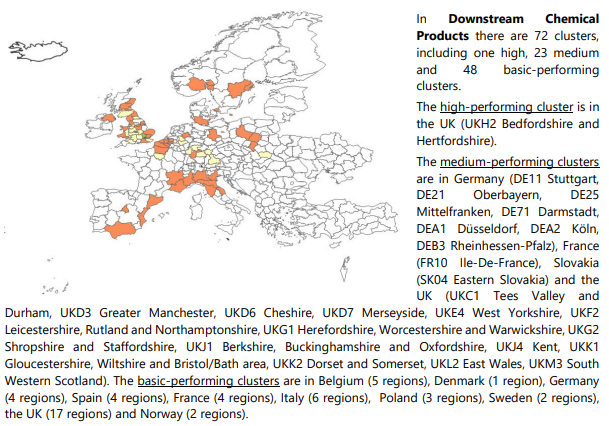Clusters to accelerate the net zero transition
Clusters are a major part of industrial landscapes. They play a crucial role, have shown resilience during economic crises, boosting collaboration, connecting enterprises, and building bridges across Europe’s ecosystems.
What are industrial clusters?
Industrial clusters are characterized as geographic areas that comprise co-located companies representing either a single or multiple industries. The presence of multiple industrial energy consumers in close proximity creates opportunities to scale low-carbon technologies by aggregating demand and forming a captive market. With the ability to share risk and resources among multiple partners, industrial clusters also allow for the creation of a digital integrated system that is cleaner and more reliable.
Achieving net-zero future with industrial clusters. Accenture, 2021.
There are 2,950 regional industrial clusters, which account for almost every fourth job in Europe (61.8 million jobs or 23.4% of total employment) and about half of employment in exporting industries (50.3%). Productivity in clusters is much higher than average productivity, corresponding to a 25% above average productivity effect. Moreover, productivity increases with cluster strength. In Upstream Chemical Products, which involves 53 clusters, productivity in high-performing clusters is 145 percent above average productivity, meanwhile in Downstream Chemical Products, which can be found in 72 clusters, productivity in high-performing clusters is 50 percent above average productivity.
Achieving deep decarbonisation globally will only be feasible if industrial clusters reduce their GHG emissions significantly. As CO2 emission reduction regulation in Europe becomes increasingly stringent, industrial clusters face growing pressure to change their production technology as well as their product portfolio.
For example, the most direct challenge for funding Carbon Capture Storage in regional industrial clusters is whether the deployment of full chain CCS could potentially generate sufficient GDP, income and revenue to justify policy action to protect the competitiveness of capturing firms. In addition to a range of other likely demands on public resources in supporting infrastructure and regulatory requirements. The capital costs due to transport infrastructure in CCS ecosystems form a relatively small proportion (10–20%) of the total when several projects cluster and share costs.
In literature, it is also argued the requirement of a stronger consideration of transformative change in the regional economic evolution. The selection environment of regional innovation systems (RIS) shifts away from related variety towards increasingly connecting different industries and actors along the value chain, that is, new linkages between seemingly unrelated industries.
At a similar regional level, the European Clusters Alliance calls for the recognition of clusters as a strategic agent for the drafting and implementation of the European recovery initiatives. Moreover, at European level, there are already partnerships led by clusters working on priority areas for the European Commission, such us the PIMAP, Photonics for International Markets and Applications. The ecosystem supporting photonics and advanced manufacturing is well developed, meanwhile for the three main areas of interest in the chemical industry case, hydrogen, circularity and carbon capture, there are only case studies at this point in time.
In the international sphere, the Transitioning Industrial Clusters Towards Net Zero initiative, created at COP26, aims to create a global movement to accelerate the transformation of industrial clusters needed for net-zero emissions. This initiative equips public, private and governmental agencies with the tools and knowledge-sharing platforms to steer low carbon targets. The initiative launched by the WEF, Accenture and EPRI alongside CEOs of industrial clusters from the UK, Australia and Spain. A year later, four leading industrial clusters in the Netherlands, Belgium and the US announced they joined the initiative to reduce their carbon emissions faster.
Closing the loop, European clusters should not only be part of the recovery initiatives but also drive the agenda. In particular, the chemical clusters could play a crucial role if they become part of other collaboration schemas.


